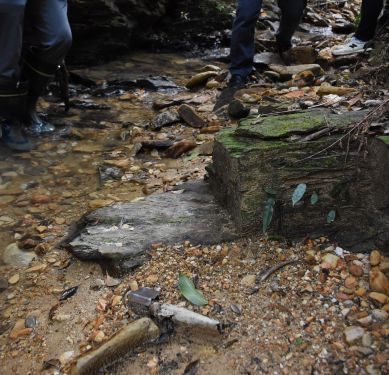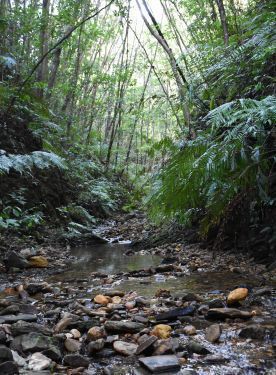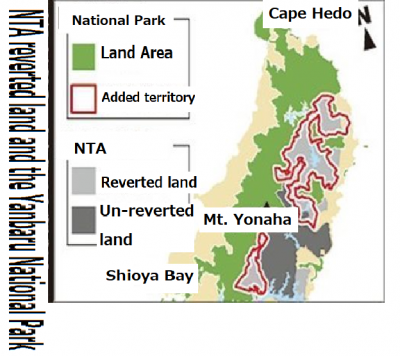Two years after its return to Japan, the Northern Training Area remains littered with used flares, un-fired bullets, and the remains of pre-war life

A used flare, comprised of a round attached to a propeller, dropped among the stones along a river. December 16, Ada, Kunigami
December 24, 2018 Ryukyu Shimpo
By Yuri Shimizu
On December 25, it will have been once year since the reversion of the U.S. military’s Northern Training Area (NTA) land to landowners.
I took a walk through this land, led by Akino Miyagi, who researches insects in the area that once was Ada, Kunigami.
I can hear the chirps of birds, and butterflies flutter through the air. Stepping into this green forest, which has been incorporated into Yambaru National Park, deep in my bones I feel the sense of “return.”
At the same time however, as my eyes pass over un-fired bullets and used up flares from the U.S. military, the reality of a forest in pain is thrust before me.
In December of 2016, it was announced that 4,000 hectares of the NTA would be returned to Japan.
On the 16th of this month, I entered into the overgrown vegetation of the former training area from the side of the road.
After walking for about ten minutes along an animal trail with tree branches jutting out into it, suddenly I came upon the remains of a helipad used by the U.S. prior to the reversion.
On top of the gravel-covered remains of the helipad was a scattering of trash covered by a blue tarp.

Unused rounds found while walking through the forest. The eight in the front are 6.5 cm rounds, and the four in the back are 4.7 cm rounds
“Even after Japan came in to clean up, we still find a lot of un-fired bullets,” explains Miyagi.
Brushing aside leaves, I raked my fingers through the dirt and fell the smooth hard sensation of metal, and pulled some of these un-fired rounds from the ground.
In just over an hour, we were able to find 12 of these unused bullets.
The image of this reverted forest being free of ammunition now seems like a faraway thing.
There were also plastic wrappings from soldier rations, as well as concrete that appeared to be for industrial use.
We then climbed down from the top of the mountain to about halfway down.
As the “pyoi pyoi” warble of a Ryukyu robin, a Japanese-designated natural monument, echoes through the forest, a sword-tail newt endemic to the Ryukyus leaps out from the side of the trail.
Meanwhile, a Mycalesis madjicosa butterfly, another Ryukyu native, leisurely dances its way around a fir tree.

The Ryukyu-native sword-tail newt found along the trail

Water seeping from the ground to form a river. This unique area is home to countless native species
As we made our way down the mountain, the temperature began to rise, and water began to seep out from the ground.
It gradually became a waterway before forming a river. We walked along the clear steam, we came across the gray and rusted remains of a used flare dropped on the ground.
The sudden appearance of this refuse once again reminded us that this quiet forest was once a military training ground.
Deep in the mountains, we also discovered the remains of a pre-war kiln that was about three meters in diameter. “This area, where people used to live, has finally been returned to us. It had been taken by the U.S. military,” said Miyagi lively, before a frustrated expression appeared on his face.
The next day, December 17, I asked a police officer at the Ada Police station about the collection of the un-used ammunition.
“Has someone else found them too?” the officer asked as if it was something he was accustomed to.
He continued that the bullets should be given to the Okinawa Defense Bureau (ODB).
Miyagi claims that over the past year he has discovered over 250 bullets.

NTA reverted land and the Yanbaru National Park
“Kyo-ro-ro-ro-ro.” As the officer collected the bullet from me, and Okinawan Rail announced its existence with its song.
<Key Term> The U.S. Military’s Northern Training Area (NTA)
On December 22, 2016, the U.S. military announced that it would be returning 4,010 of the NTA’s total 7,513 hectares.
The cleanup of the area was carried out by Japan, not the U.S. military, and over a four month period the Okinawa Defense Bureau (ODB) engaged in a cleanup project over a 50,000 square meter area that included 10 disposal sites and decommissioned helipads.
Then, the land was officially returned to landowners on December 25, 2017.
In June of 2018, 3,700 hectares, or 90% of the reverted land, was incorporated into Yanbaru National Park.
There is now an effort afoot to have the area listed as a world natural heritage site in 2020.
(English translation by T&CT and Sam Grieb)
Previous Article:Sukuta Ward in Nago demands Okinawa Defense Bureau take preventative measures after latest U.S. military stray bullet incident
Next Article:White House petition to halt Henoko construction reaches 100,000 signature goal in 10 days
[Similar Articles]
- U.S. military still using land after its return; 342 unused bullets, field rations waste, and other garbage found on former NTA land
- Yambaru forest to be designated as national park, but not including US training area
- Researcher spots U.S. military helicopter landing on former NTA land in Ada, Kunigami Village
- U.S. soldiers trespass on walking trail in Nago
- U.S. military returns Gimbaru Training Area to the locals
 Webcam(Kokusai Street)
Webcam(Kokusai Street)


